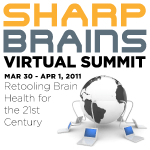7 Key Lessons from the 2011 SharpBrains Summit: Retooling Brain Health for the 21st Century
 SharpBrains served a highly thought-provoking and informative 2011 Virtual Summit on Retooling Brain Health for the 21st Century over 3 days, March 30th — April 1st. Here is a brief distillation of the large number (40+) of presentations.
SharpBrains served a highly thought-provoking and informative 2011 Virtual Summit on Retooling Brain Health for the 21st Century over 3 days, March 30th — April 1st. Here is a brief distillation of the large number (40+) of presentations.
1.The range and variety of presentations left no room for doubt that the digital brain health market is concerned with much more than improving cognitive performance and preventing/treating disease. There is a need for many tools in each of the following categories: computerized assessment for myriad cognitive, psychological and neurological concerns; data analysis and recommendation systems; interventions for manifold clinical and non-clinical problems; measurement of the effectiveness of interventions; dynamic feedback and intervention adjustment. Significant developments were presented in each of those areas. Moreover, there was an equal emphasis on research and development for maintenance, prevention, treatment and enhancement of brain function across the lifespan.
2.A “one size fits all” approach is clearly not appropriate to all of the foregoing concerns. For example, not all lifestyle guidelines or brain training programs or drugs have the same effects. Some tools may enhance mechanisms used by many cognitive skills. Others are targeted at mechanisms involved in fewer types of tasks. Transfer is hard to obtain. Yet Dr. Bavelier presented impressive research suggesting that some action programs enhance some users’ executive control and selective attention (with broad transfer) whereas software games that do not present competing attentional targets (e.g., Tetris) did not improve selective attention. Equally impressive research by Dr. Jerri Edwards and Dr. Sophia Vinogradov showed how targeted cognitive training can support driving safety and mental health. The generality of these findings remain to be determined (e.g., does the same training improve one’s ability to filter out internal motivators on more self-regulated tasks?).
To guide consumers and front-line practitioners, we need to provide transparent information about evidence-based programs that target mechanisms underlying skills that matter to them – and we need a clear assessment-based system to personalize interventions. Consumers needing to keep focused in dynamic environments would require different software than if they need to keep more information in working memory. Customers aiming to drive more safely should consider programs specifically designed and tested to improve driving (some of them affect field of view and reaction times). There is no silver bullet that is useful for everything.
 3.While there is no silver bullet, there are requirements that apply to many training concerns. Several were voiced by Summit speakers. For example,
3.While there is no silver bullet, there are requirements that apply to many training concerns. Several were voiced by Summit speakers. For example,
- being based on scientific constructs,
- being independently and rigorously tested,
- dynamically monitoring and analyzing performance,
- dynamically adjusting treatments and challenge levels based on the dynamic analyses, and
- providing meaningful feedback to users or clinicians.
Such criteria apply to a wide range of programs each targeted at different concerns.
4.There was again broad recognition amongst presenters and participants that a holistic, integrative approach to brain health is required.
5.Given the complexity of the mind and brain and the tasks outlined above, researchers and manufacturers need to develop and adopt innovative, collaborative and economical research strategies. Indeed, we heard that some cognitive training product developers have already created research platforms to allow independent researchers to assess their software and analyze (anonymized) data. Some of these developers can serve up numerous data to scientists from each of thousands and even millions of users. This will allow scientists to answer questions that could not adequately be addressed in the past. The questions are not merely about the validity and effects of the commercial software: All kinds of mental mechanisms can be explored with these new platforms. This also distributes and lowers the overall cost of doing research.
Having led the development of a data-intense research platform in a cognate field (education) with Dr. Phil Winne at SFU, I know that the new data processing requirements will push the boundaries of traditional statistical analyses in psychology and neuroscience in exciting ways. It will lead to major innovations in the analysis of data, including the importation and development of techniques from computer science, mathematics and artificial intelligence.
6.Another implication of the complexity of this field is a need for innovative ways of funding research, product development and marketing of new products.
- Baycrest described how over 50% of their funding comes from public sources.
- Dr. Walter Greenleaf, of Virtually Better, suggested specific challenges and strategies that startups should consider in bringing products to markets.
- Some presenters recognized that cognitive training products are currently too expensive for widespread adoption.
- Dr. Henry Mahncke, CEO of Posit Science, suggested that consumers could reasonably be paid to use these products. For example, insurance companies could provide discounts to customers who train with software that demonstrably lowers accident rates.
- At last year’s Summit, we heard that Young Drivers of Canada provides licenses of such software to their students. At this year’s Summit we heard how Allstate provides programs for free to their insured.
- Some companies, such as Nationwide, now issue wellness credits to employees for using select online brain wellness platforms. In other words, the cost of new solutions and services can be split amongst different entities who have a financial stake in the user’s mental capabilities and overall brain health.
7.We are at an early stage of market development — with associated opportunities and challenges. Robin Klaus from Club One noted that it in the 1960s, it was strange to see people jogging. Not so by the late 70s. He proposed that people who are already actively interested in their health will form the leading edge of adoption of brain fitness technology. I believe that people whose livelihoods are predicated on their cognitive performance, i.e., knowledge workers, will also be early adopters. We can expect the numbers of users to increase as a function of the availability of products that meet customer needs and the market’s recognition that those needs are significant.
And one bonus key lesson…
7+1. The Virtual Summit was a true Summit, the best of what a conference can offer, not a one-way communication channel. There was a large number and range of formal presentations, and each one was followed by an interactive question period during which participants could ask questions (in a chat box) to which presenters verbally responded. There were also two chat rooms opened for discussion during several breaks. And a LinkedIn group was created for followup discussions. This allowed participants to continually raise very many germane questions and points, such as a request for sharing negative results. I.e., we ought to expect independent researchers to produce not only a steady stream of corroborations; they will discover failed conjectures, limitations, and optimal operating parameters. Being able to bring to the table (a virtual table, that is) hundreds of stakeholders representing all sectors and over 10 countries for 3 days is something difficult to imagine in the so-called “real” world. This continued forward-looking and cross-sector conversation can help advance this area of science and technology.
Of course, many other ideas were mooted, questions raised and answered, and new human connections forged in this ongoing discussion about one of the most important contemporary topics: how to measure, develop and maintain the health and performance of our most precious asset, our human brains.
 –Dr. Luc P. Beaudoin is Adjunct Professor of Education at Simon Fraser University. He specializes in theoretical and applied cognitive science. He has been doing research and development on integrated learning environments since 2001. He is also doing research and development in the areas of cognitive fitness and productivity. He was a first-round employee of two of Canada’s most successful high-tech startups. He has also been Assistant Professor of Military Psychology and Leadership.
–Dr. Luc P. Beaudoin is Adjunct Professor of Education at Simon Fraser University. He specializes in theoretical and applied cognitive science. He has been doing research and development on integrated learning environments since 2001. He is also doing research and development in the areas of cognitive fitness and productivity. He was a first-round employee of two of Canada’s most successful high-tech startups. He has also been Assistant Professor of Military Psychology and Leadership.
—
To learn more: 2011 Virtual Summit on Retooling Brain Health for the 21st Century


